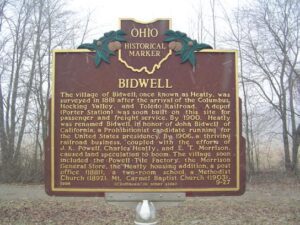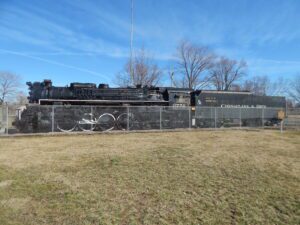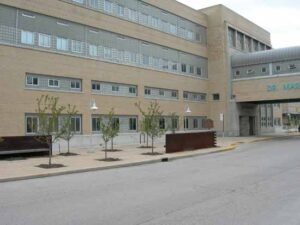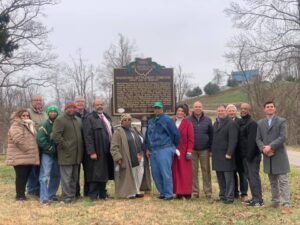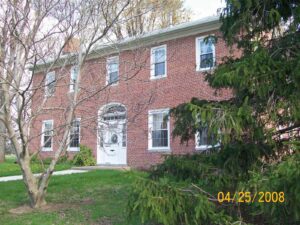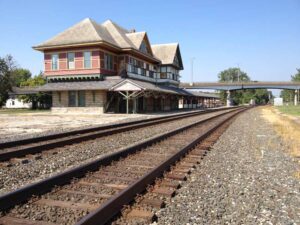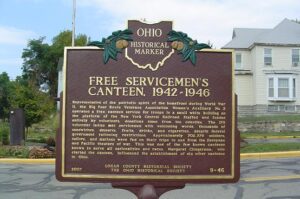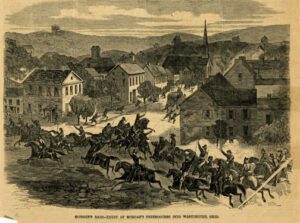, OH
The village of Bidwell, once known as Heatly, was surveyed in 1881 after the arrival of the Columbus, Hocking Valley, and Toledo Railroad. A depot (Porter Station) was soon built on this site for passenger and freight service. By 1900, Heatly was renamed Bidwell, in honor of John Bidwell of California, a Prohibitionist candidate running for the United States presidency. By 1906, a thriving railroad business, coupled with the efforts of J.K. Powell, Charles Heatly, and E.T. Morrison, caused land speculation to boom. The village soon included the Powell Tile Factory, the Morrison General Store, the Heatly housing addition, a post office (1881), a two-room school, a Methodist Church (1892), Mt. Carmel Baptist Church (1903), (Continued)
, OH
Granville T. Woods was a pivotal African American inventor during the late 19th and early 20th centuries. Woods’ invention of the telegraph device that enabled railway companies to know the location of each of their trains. This new technology greatly enhanced train scheduling and reduced the frequency of fatal collisions throughout the railway industry. From 1878 through 1880 Woods was a railroad locomotive engineer employeed by the Springfield, Jackson and Pomeroy Railroad Company and later by the Dayton and Southeastern Railroad. With frequent stops in Washington Courthouse and extensive leisure time, Woods learned telegraphy from a local telegraph operator. (Continued on other side)
, OH
The first railroad to operate west of the Allegheny Mountains was Toledo’s colorful “Erie and Kalamazoo.” Begun in 1832, the line was completed by 1836. Its rails were made of oak topped with thin iron strips. Horses pulled small railcars the 30 miles between Toledo and Adrian, Michigan. In July, 1837, a steam locomotive replaced the horses.
, OH
Macedonia Cemetery (circa 1840) belongs to Macedonia Church, Ohio’s first Black Church. Those buried include settlers of the Macedonia Free Black Settlement, built by free people who assisted freedom seekers along the Underground Railroad. Also interred are soldiers of the Civil War’s United States Colored Troops (USCT), most of whom served in the 5th Regiment, Ohio’s first Black Regiment (1863). The Polley family also rest here. Emancipated slaves, the family continued their freedom struggle when their children were kidnapped from Ohio and unlawfully sold into slavery. Macedonia’s extant burial grounds include this sacred site and another 1/2 mile north.
, OH
Wheeler Tavern was built by Portius Wheeler, an early pioneer of Hardin County, around 1835 near the Shawnee Ford of the Scioto River. According to local historians this was the first brick residence constructed in Hardin County. Tradition maintains that Wheeler Tavern was a station on the Underground Railroad, a network of contacts and places that aided escaping slaves making their way to the free North.
, OH
This Depot, dedicated on December 27, 1900, served as division headquarters for the Cleveland, Chicago, Cincinnati, and St. Louis railroad, commonly called the Big Four. Peak passenger usage occurred during and after World War I when 32 trains stopped here daily. Railway Express serviced as many as 20 trains a day into the 1950s, and Galion became a “whistle stop” for presidential campaigns with speeches from the train platform from such candidates as Al Smith in 1928, Franklin D. Roosevelt in 1932, and Dwight D. Eisenhower and Richard Nixon in 1952. In 1929 the New York Central acquired the Big Four, which moved the division headquarters west to Bellefontaine in Logan County. The ticket office remained opened until 1964, but all railroad offices closed in 1969. The Depot was listed on the National Register of Historic Places in 1974.
, OH
Representative of the patriotic spirit of the homefront during World War II, the Big Four Route Veterans Association Women’s Auxiliary No. 3 operated a free canteen service for troops in a small white building on the platform of the New York Central Railroad. Staffed and funded entirely by volunteers, donations came from ten counties. The 170 volunteer ladies met servicemen with welcoming words, thousands of sandwiches, desserts, fruits, drinks, and cigarettes, despite federal government rationing restrictions. Approximately 702,779 soldiers, sailors, and marines were fed on their trips to and from the European and Pacific theaters of war. This was one of the few known canteens known to serve all nationalities and races. Margaret Clingerman, who started the canteen, influenced the establishment of six other canteens in Ohio.
, OH
Founded November 8, 1815 by General Joseph Darlington and named for his Virginia birthplace, Winchester was incorporated in 1864 and later became the eastern terminus of the Cincinnati and Eastern Railway (1877-1880). The first locomotive to enter Winchester, the “Dick Thomson,” was named after a local businessman who was largely responsible for building the railroad. Winchester was also the birthplace of Evelyn (Longman) Batchelder, first woman sculptor to become a full academician at the National Academy of Design in 1919.


